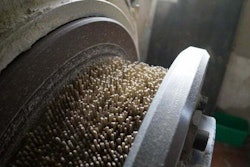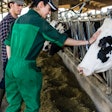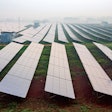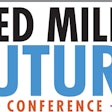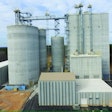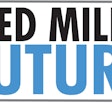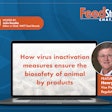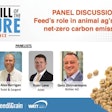Jeff Haarmann from Affordable Energy & Gas examines the energy technologies available to feed producers
In 2022, U.S. pig integrator The Maschhoffs linked itsGriggsville, Illinois, feed mill to a solar farm installationto offset its high energy needs and decrease the costs. To help the producer solve its energy problems, it worked with independent energy consultancy Affordable Gas & Electric (AGE).
AGE’s managing director Jeff Haarmann joined the Chat to discuss solar and other alternative energy solutions that can benefit feed producers now and increasingly so in the future.
Feed mills benefit from alternative energy solutions [VIDEO]fromWATT Global MediaonVimeo.
Transcription of Feed Strategy Chat with Jeff Haarmann, managing director, Affordable Gas & Electric (AGE)
Jackie Roembke, editor in chief, WATT Feed brands/Feed Strategy:Hello everyone and welcome to Feed Strategy Chat. I am your host, Jackie Roembke, editor in chief of WATT Feed brands and Feed Strategy magazine.
This edition of Feed Strategy Chat is brought to you by WATT Global Media and FeedStrategy.com. FeedStrategy.com is your source for the latest news and leading-edge analysis of the global animal feed industry.
Today we’re joined on Zoom by Jeff Haarmann, the managing director ofAffordable Gas & Electric (AGE). He’s here to talk about how feed producers can harness alternative energy sources to control costs while also reducing their carbon footprint.
Hi, Jeff, how are you today?
Jeff Haarmann, managing director, AGE:I’m great. Thank you.
Roembke:Excellent. Thanks so much for being here. Well, let’s get right into it.Tell me a little bit about AGE and its experience working with the animal feed industry.
Haarmann:Sure, Jackie, we have been working with one of the largest pork producers in the U.S. for a little over seven years now managing traditional energy procurement, as well as energy strategies in general for The Maschhoffs.
Roembke: Very good. And can you dig in a little bit to some of the factors and elements that that partnership entails?
Haarmann:Generally speaking, energy is one of the most expensive components of any feed mill, and our role is to help minimize any of those expenses that we can find whether it’s through negotiating rates, whether it’s through introducing technology, or whether it’s through energy efficiency matters that might lower the overall amount of usage that The Maschhoffs use at the mill.
Roembke: Please provide a brief overview of the alternative energy technologies that are available today.
Haarmann:Today, generally speaking, the obvious one is solar. Everybody knows solar is an option. Now, it works when the sun shines. Wind power is still a viable option for on-site generation with natural gas generators. And then, of course, you have your traditional grid. And so our strategy has always been sort of a mix of the three or four different sources, as opposed to one source alone.
Roembke: And, of the solutions that you just mentioned, which are best suited for feed production?
Haarmann:Yeah, feed production uses a lot of energy. The grid is obviously the most reliable. We would never take somebody off of the grid. But solar production is extremely reliable. And you can determine exactly what kind of energy is going to be produced based on the geography of where you are. So it’s very reliable and very predictable.
I think solar with all of the incentives that are out there is the obvious go-to, coupled with some electric grid generation.
Roembke:And you kind of touched on these things, buthow can the feed mill or the feed manufacturer benefit from the exploration and implementation of these investments?
Haarmann:Yeah, if you take off one of the most expensive, if you minimize one of the most expensive things that goes into operating a feed mill, it makes a big, big difference. And so again, our go-to motto is “Every kilowatt hour that you don’t use is the best savings you can find in an operation.”
And so coupling technology together with the traditional grid stuff, and then also looking beyond that into things like pig warming blankets, as opposed to heat lamps. They’re more efficient than the traditional heat lamp scenario that most pig producers have used in the past. So we sort of look at all options, and put them all on the table to explore how we can minimize those overall energy spends.
Roembke: How can companies interested in exploring these technologies? Where do they get started? What do they do?
Haarmann:They have to go to somebody that knows energy, obviously. That is, it’s a commodity, but it’s also a strategy, and so if you’re in a regulated state — there’s 14 or 15 states that are deregulated, where you can go get competitive energy — but if you’re in a regulated state, you’ve got to go probably to efficiency first, and then technology. But if you’re in a deregulated state, like in Illinois, you’re going to negotiate rates first, that’s the easiest, then you’re going to go to energy efficiency, make yourself as most efficient as possible.
And then you’re going to go turn to some of the technologies that are out there, including some of the newer technologies that are going to be available in the very near future that are going to be viable, like battery storage. And so start with the basics, procure your energy, as a rate, minimize the overall amount to use as energy efficiency world, and then look to technology to deliver the biggest savings that you can find, coupled with the traditional grid.
Roembke:Thank you so much for those insights. For a deep dive on some of the things that Jeff spoke about here today — and if you’ll be at IPPE 2023 in Atlanta —consider joining us at the Feed Mill of the Future Conference on January 24. Here, Jeff will present his presentation, “Managing your energy spend through on-site generation solutions.”
For more information, please visitwww.feedmillofthefuture.com.
Thank you so much, Jeff. And thanks to you for tuning in.
= Event At-A-Glance =
2023 Feed Mill of the Future Conference
How efficiency, innovation and sustainability
will shape the feed industry of tomorrow
Co-located with IPPE 2023 | Atlanta, GA, USA
January 24, 2023 | 8 a.m. – 12:00 p.m. | Room B203
Fee:$95 early bird | $125 after Jan. 6, 2023
View the full agenda here:www.feedmillofthefuture.com
How to register:To attend the Feed Mill of the Future Conference, attendees must first register
to attend IPPE.Register today for the lowest ticket price, go towww.ippexpo.org, and visit the “Education Programs” for details.





